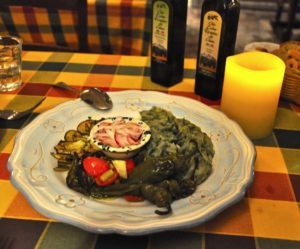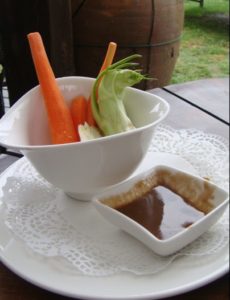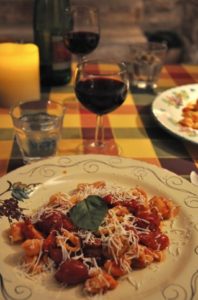
While the land is arid, it’s very alive. There are olives, fruits, vegetables and grapes growing everywhere, like no other region I’ve ever seen. Just across the stone wall from our suite at the masseria was a huge field sprouting with broccoli surrounded by giant olive trees. The air had a nice scent of fresh broccoli (not cooked ;) ). The masseria’s huge garden was an abundance of artichokes, chicory, fennel, figs, almonds, radishes and early buds of grapes.

Pranzo, or lunch, is the heartiest meal of the day and what most locals keep sacred (thus town shops closing from 1-4pm daily). Cena, dinner, is more simple. On our visit we typically reversed it although most days we had three full meals… couldn’t turn down the masseria’s amazing fresh local breakfast.
In Pugliese cuisine, you’ll find…
* Olives: Whether it’s the olive or the oil, most meals start with this. Most abundant are the green Cerignola olives. The olive oil is all extra virgin and because of the above point it’s often referred to as ‘liquid gold.’ Best regions for olive oil, all with DOP grading (denomination d’ origin protetta), are the Salento around Lecce, Fasano and around Brindisi.
 * Fruits and Vegetables: Tomatoes are another staple here but that’s just the beginning. Eggplant and zucchini… deliciously fried up for antipasta or grilled in pastas. We started every meal with sopratavola, raw vegetables usually including fennel, chicory, carrots and cocomeri (a tiny mild cucumber). In earlier times sporatavola was eaten after a meal as the peasants couldn’t afford fruit. Cicorie, wild chicory, was a new one for me and is used in abundance especially cooked up in the local specialty purea di fave, fava bean puree (fava beans cooked up with olive oil and chicory until its a deep green). Legumes, like fava bean and ceci (chickpea), you’ll also find as a staple. Fruits like cherries, grapes and figs were in season during our visit. Later in the summer add pomegranates, watermelon, melons, peaches, strawberries and raspberries.
* Fruits and Vegetables: Tomatoes are another staple here but that’s just the beginning. Eggplant and zucchini… deliciously fried up for antipasta or grilled in pastas. We started every meal with sopratavola, raw vegetables usually including fennel, chicory, carrots and cocomeri (a tiny mild cucumber). In earlier times sporatavola was eaten after a meal as the peasants couldn’t afford fruit. Cicorie, wild chicory, was a new one for me and is used in abundance especially cooked up in the local specialty purea di fave, fava bean puree (fava beans cooked up with olive oil and chicory until its a deep green). Legumes, like fava bean and ceci (chickpea), you’ll also find as a staple. Fruits like cherries, grapes and figs were in season during our visit. Later in the summer add pomegranates, watermelon, melons, peaches, strawberries and raspberries.
 * Pasta: THE famous pasta from this region is orecchiette meaning ‘little ears’ often served simply delicious with oven-roasted tomatoes, olive oil and garlic. We also had a yummy trofiette pasta with fava bean puree, crispy artichoke leaves and baby shrimps.
* Pasta: THE famous pasta from this region is orecchiette meaning ‘little ears’ often served simply delicious with oven-roasted tomatoes, olive oil and garlic. We also had a yummy trofiette pasta with fava bean puree, crispy artichoke leaves and baby shrimps.
* Bread: Made from the local durum wheat, the typical loaf is a hearty bread with a crunchy crust and chewy inside. Perfect for soaking up your pasta’s sauce, or fare scarpett (‘to make a little shoe’) as they say in Italian. My FAVORITE bread is the taralli, little baked dough knots like an Italian pretzel made of simply wheat flour, olive oil and white wine. We had them with sopratavola before almost every meal.
* Cheese: The specialty here is the fresh and creamy kind…burrata. A type of mozzarella (which is originally from here too) it’s a little round of stretched curd cheese filled with cream. When you cut it open, the creamy cheese just oozes out. Yum!
* Seafood: Mussels, octopus and prawns everywhere. Mussels make the very popular and traditional Pugliese dish riso cozze e patate (rice, mussels and potatoes) baked in the oven (also known as taieddha in Lecce where zucchini is added). One night at the masseria we had a delicious local Adriatic Codfish with spicy cherry tomatoes and eggplant. One lunch was a simple salad of shrimp, avocado and cherry tomatoes.

* Pastries: Flaky pastries in savory or sweet. THE best we’ve ever had was the Rustica at La Rusticana in Lecce. This local specialty is a flaky pastry shaped like a cinnamon roll filled with mozzarella cheese, tomatoes and a little béchamel sauce. Yum!! For sweet, try zeppelin and sporcamusi, both phyllo type pastries filled with custard, or cassatina, a yummy spongecake.
Squisito!! I made notes on all our meals and pictures so I could write for hours. But now on to the Pugliese wine to accompany this amazing food!
